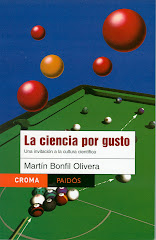by Martín Bonfil Olivera
Published on Milenio Diario, October 29, 2008
 For more than 10 years, all around Mexico-and other nations- the National Week of Science and Technology has been celebrated. It is endorsed by Conacyt -the State Council for Science and Technology-, several Universities and educational institutions, private companies and all kinds of groups and people interested in promoting the scientific culture in our Country.
For more than 10 years, all around Mexico-and other nations- the National Week of Science and Technology has been celebrated. It is endorsed by Conacyt -the State Council for Science and Technology-, several Universities and educational institutions, private companies and all kinds of groups and people interested in promoting the scientific culture in our Country.
As a matter of fact, the "week" has passed its official limits and has turned, in many places, into a full month dedicated to science and technology, with all kinds of activities: conferences, science fairs with experiments, exhibitions, courses, workshops, contests and even concerts, rallies and scientific marathons.
This year, I had the privilege of being invited to
Why this urge to popularize science? What justifies this scientific evangelization by science comunicators? Is it justifiable to spend public money in this task?
The answer deals with, not only the intrinsic value of science and technology, as manifestations of human culture -culture that deserves being spread. It is also related with its tremendous practical importance. The products of technology derived from scientific knowledge (communications, computers, vaccines, transportation, energy…) change, more profoundly every time, our lifestyle and our life level.
Besides, scientific knowledge gives us a very reliable and realistic vision of the world that surrounds us, and of our place in it. Finally, a basic scientific culture is required so that a citizen can assume its responsibility in decisions related with scientific and technical subjects (cloning, mother cells, euthanasia, abortion, transgenic cultures, nuclear energy…).
Investing and spreading scientific knowledge is worth the effort: it may fructify, in the long term, in a more prosperous and democratic society. For all of the above, long live Science and Technology week!
(translated by Adrián Robles Benavides)
To receive Science for pleasure weekly
in your email, subscribe here!








